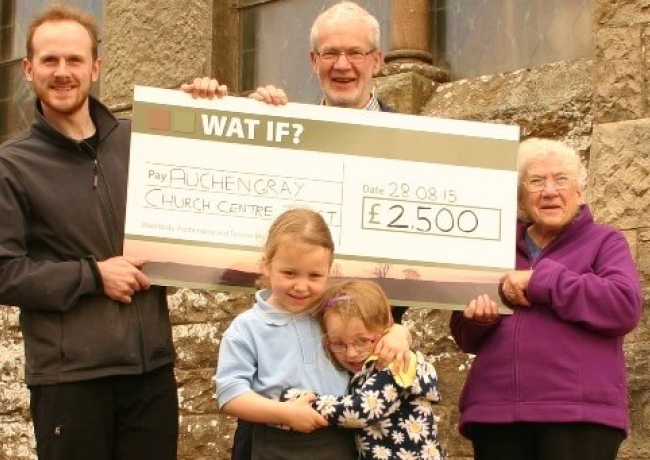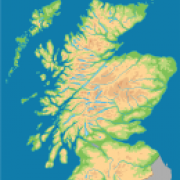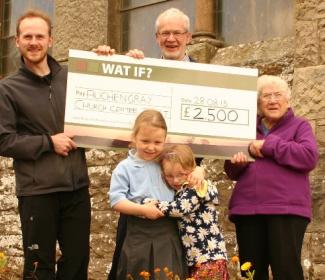WAT IF?

Contact details: Jemma Black
Development Officer
jemma@watif.scot

Location
What are the aims of your project?
Woolfords Auchengray and Tarbrax Improvement Foundation (known as WAT IF?) was established as a Scottish Charitable Incorporated Organisation (SCIO) on 28th November 2012.
The aims of WAT IF are to engage in activities which benefit and support the rural community principally by:
-
Attracting funding to resource local projects and activities
-
Administering those funds in accordance with criteria set out by Trustees
Examples of the types of project supported/undertaken could include:
-
Advancement of rural regeneration and community development, so that the Auchengray area can be a sustainable, inclusive community for all who live or work in the area
-
Promotion of the conservation, protection and improvement of the physical and natural environment
-
Encouraging access to open spaces and enhancement of recreational opportunities
-
Advancement of heritage, culture, history, arts, science and education, including lifelong learning
-
Other similar schemes and projects of a charitable nature for the benefit of the community
How did your project achieve these aims?
A community consultation was undertaken in 2013, funded by South Lanarkshire’s LEADER+ programme. The response rate was approximately 30% with a total of 213 individuals, nine farms and nine representatives of community groups returned completed questionnaires.
The results provide a representative sample of views from the population and different interest groups in the area. They provide:
-
An evidence base and mandate to WAT IF? for development work
-
Priorities that the community wants to action
-
A feasible plan of work to tackle within the next five years
Five themes were established out of the responses which form the basis of the Community Action Plan:
- Roads and transport
- Green space and heritage
- Village enhancement and facilities
- Community activities
- Services and communications
Who's involved?
As a SCIO there is a board of trustees and a management committee who oversee the running of the Trust and the implementation of the action plan. In October 2014 the Trust took on a Development Officer on an initial six-month contract to aid the implementation of the action plan, this contract has now been extended until 2016.
There are working groups of volunteers for each theme and general volunteers who get involved in various projects and events.
Membership is open to all persons who accepted the aims of the organisation and reside within the WAT IF? area.
How was the project funded?
WAT IF? as an established active Community Trust receive community benefit funding from local windfarms, and also apply for grants where necessary for particular projects.
The Trust itself also runs two grant schemes; the small scheme for applications up to £500 and the large grant scheme awards up to £2,500 twice a year.
Where did you go for help and advice?
The Development Trust Association Scotland was very helpful in getting our community consultation underway and the DTAS website provides a good source of advice and information.
Other community trusts in the area are a good contact to have, as many have come across similar challenges as WAT IF? encounters and it’s a good idea to share best practices.
The Scottish Council for Voluntary Organisation website is fantastic for guidelines and advice on establishing a community group, how to run a village hall, legal requirements etc.
What has been your greatest achievement so far?
Since 2011 the Trust has come a long way, producing the community action plan in 2013 was certainly a challenge and an achievement and this had helped set the targets for the next five years.
The first large project carried out in 2014 was the refurbishment of Woolfords Village Hall, and this has been a great achievement; it has a visual impact on the village and the hall itself is now a useful space that has many possibilities. Already there is a meditation class, a youth club and several craft workshops making use of the space! The refurbishment was possible through funding from the Levenseat Trust and also some community benefit monies.
And the biggest challenge?
As the Trusts area has three villages, each with their own identity and needs, as well as a lot of individual settlements away from the villages, the challenge is ensuring that the needs of all residents in the area are taken into consideration and through regular communication and consultation we can build a Trust which responds to local needs.
Coming from a voluntary perspective, the time and energy spent in getting to where the Trust is today cannot be underestimated and the projects have been developed to a level that wasn’t envisaged at the start of the journey, and so there have been challenges at each and every stage. This is why it is so important to take time to recognise and celebrate successes!
Any tips for those setting up a similar project?
Seek out advice at any and every opportunity, a project such as WAT IF for a local community is a steep learning curve. Ask for help from relevant groups/bodies but don’t hesitate to approach individuals and ask for their help, especially people in your own community. There are plenty people who have the skills to get involved but do not want to come forward, but are delighted to be approached and then get involved.
Most importantly don’t take it personally, it is very important to get community engagement but you are never going to get full engagement and be proud of your achievements, always try to remember as a volunteer why you first got involved.
What's next for your project?
Currently the Trust is trialling a Community Minibus, to guage demand for a service into West Lothian; this will provide evidence for any future sustainable transport project.
There are key priorities that need to be addressed in the area, including poor phone signal and broadband service. The Trust is working with Community Broadband Scotland and BT to investigate options for improving broadband service in the area.
- Log in to post comments
